Frigidaire FFGH3054UB Manual
Frigidaire
Komfur
FFGH3054UB
Læs gratis den danske manual til Frigidaire FFGH3054UB (38 sider) i kategorien Komfur. Denne vejledning er vurderet som hjælpsom af 11 personer og har en gennemsnitlig bedømmelse på 5.0 stjerner ud af 6 anmeldelser. Har du et spørgsmål om Frigidaire FFGH3054UB, eller vil du spørge andre brugere om produktet?
Side 1/38

All about the
Use & Care
of your
www.frigidaire.com USA 1-800-944-9044 www.frigidaire.ca Canada 1-800-265-8352
Gas Range
A13080801 Rev A (June 2018)
TABLE OF CONTENTS
Product Record and Registration . . . . . . . . . . . . . . 2
Important Safety Instructions . . . . . . . . . . . . . . . . . 3
Cooking Recommendations . . . . . . . . . . . . . . . . . 10
Before Setting Surface Controls . . . . . . . . . . . . . . 13
Setting Surface Controls . . . . . . . . . . . . . . . . . . . . 16
Before Setting Oven Controls . . . . . . . . . . . . . . . . 18
Setting Oven Controls . . . . . . . . . . . . . . . . . . . . . . 19
Care and Cleaning . . . . . . . . . . . . . . . . . . . . . . . . 29
Before You Call . . . . . . . . . . . . . . . . . . . . . . . . . . . 34
Warranty . . . . . . . . . . . . . . . . . . . . . . . . . . . . . . . . 38

22018 Electrolux Home Products, Inc. All rights reserved. Printed in the USA
Product Registration . . . . . . . . . . . . . . . . . . . . . . . . . .2
Product Record and Registration . . . . . . . . . . . . . . . . . 2
Need Help? . . . . . . . . . . . . . . . . . . . . . . . . . . . . . . . . .2
Important Safety Instructions . . . . . . . . . . . . . . . . . . . . 3
Cooking Recommendations . . . . . . . . . . . . . . . . . . . . 10
Before Setting Surface Controls . . . . . . . . . . . . . . . . 13
Setting Surface Controls . . . . . . . . . . . . . . . . . . . . . . . 16
Before Setting Oven Controls . . . . . . . . . . . . . . . . . . . 18
Setting Oven Controls . . . . . . . . . . . . . . . . . . . . . . . . . 19
Care and Cleaning . . . . . . . . . . . . . . . . . . . . . . . . . . . . 29
Oven Baking . . . . . . . . . . . . . . . . . . . . . . . . . . . . . . .34
Before You Call. . . . . . . . . . . . . . . . . . . . . . . . . . . . . . . 34
Warranty . . . . . . . . . . . . . . . . . . . . . . . . . . . . . . . . . . . . 38
Questions?
For toll-free telephone support in the U.S. and Canada call
1-800-944-9044 (is Canada just for Electrolux?)
For online support and Internet production information visit
http://www.frigidaire.com.
Product Registration
Registering your product with Frigidaire enhances our
ability to serve you. You can register online at
http://www.frigidaire.com or by dropping your Product
Registration Card in the mail.
Record model & serial numbers here
Purchase Date
Frigidaire model number
Frigidaire serial number
Serial Plate Location
Serial plate location: open lower oven drawer (some
models) or storage drawer (some models).
PRODUCT RECORD AND REGISTRATION
Thank you for choosing Frigidaire.
Important: This Use and Care Guide is part of our commit-
ment to customer satisfaction and product quality
throughout the service life of your new appliance. We view
your purchase as the beginning of a relationship. To ensure
our ability to continue serving you, please use this page to
record important product information.
Need Help?
Visit the Frigidaire web site at www.frigidaire.com
Before you call for service, there are a few things you can
do to help us serve you better.
Read this Use & Care Manual
This manual contains instructions to help you use and
maintain your range properly.
If You Received a Damaged Range...
Immediately contact the dealer (or builder) that sold you the
range.
Save Time and Money
Check the section title “Before You Call”. This section helps
step you through some common problems that might occur.
If you do need service, help is only a phone call away. Call
Frigidaire Customer Services at 1-800-944-9044.

3
Read all instructions before using this appliance.
This manual contains important safety symbols
and instructions. Please pay attention to these
symbols and follow all instructions given.
Do not attempt to install or operate your appliance
until you have read the safety precautions in this
manual. Safety items throughout this manual are
labeled with a WARNING or CAUTION statement
based on the risk type.
Warnings and important instructions appearing in
this guide are not meant to cover all possible
conditions and situations that may occur.
Common sense, caution, and care must be
exercised with installing, maintaining, or operating
your appliance.
DEFINITIONS
This is the safety alert symbol. It is used to
alert you to potential personal injury hazards.
Obey all safety messages that follow this symbol
to avoid possible injury or death.
Indicates a potentially hazardous situation
which, if not avoided, may result in death or
serious injury.
Indicates a potentially hazardous situation
which, if not avoided, may result in minor or
moderate injury.
Indicates installation, operation, maintenance,
or valuable information that is not hazard
related.
Indicates a short, informal reference –
something written down to assist the memory or
for future reference.
WARNING
CAUTION
IMPORTANT
NOTE
If the information in this manual
is not followed exactly, a fire or explosion may
result causing property damage, personal
injury or death.
FOR YOUR SAFETY: Do not store or use
gasoline or other flammable vapors and
liquids in the vicinity of this or any other appli-
ance.
WHAT TO DO IF YOU SMELL GAS:
•Do not try to light any appliance.
•Do not touch any electrical switch.
•Do not use any phone in your building.
•Immediately call your gas supplier from a
neighbor's phone. Follow the gas
supplier's instructions.
•If you cannot reach your gas supplier, call
the fire department.
Installation and service must be performed by
a qualified installer, servicer, or the gas
supplier.
IMPORTANT SAFETY INSTRUCTIONS

4
IMPORTANT SAFETY INSTRUCTIONS
IMPORTANT INSTRUCTIONS FOR
UNPACKING AND INSTALLATION
IMPORTANT - Read and follow the below instruc-
tions and precautions for unpacking, installing,
and servicing your appliance:
Remove all tape and packaging before using the
appliance. Destroy the carton and plastic bags
after unpacking the appliance. Never allow
children to play with packaging material. Do not
remove the wiring label and other literature
attached to the appliance. Do not remove model/
serial number plate.
Cold temperatures can damage the electronic
control. When using this appliance for the first
time, or when the appliance has not been used
for an extended period of time, be sure the
appliance has been in temperatures above 32ºF
(0ºC) for at least 3 hours before turning on the
power to the appliance.
Never modify or alter the construction of the
appliance by removing the leveling legs, panels,
wire covers, anti-tip brackets/screws, or any other
part of the appliance.
Be sure to have an appropriate foam-type fire
extinguisher available, visible, and easily acces-
sible located near the appliance.
WARNING
Tip Over Hazard
• A child or adult can tip
the range and be killed.
• Verify the anti-tip device
has been installed to floor
or wall.
• Ensure the anti-tip device is
re-engaged to floor or wall when the
range is moved.
• Do not operate the range without the
anti-tip device in place and engaged.
• Failure to follow these instructions can
result in death or serious burns to
children and adults.
Range
leveling
leg Anti-tip
bracket
To check if the anti-tip bracket is installed
properly, use both arms to grasp the rear edge
of the range back. Carefully attempt to tilt
range forward. When properly installed, the
range should not tilt forward.
Refer to the anti-tip bracket installation instruc-
tions supplied with your range for proper
installation.
Air curtain or other overhead range hoods which
operate that operate by blowing a downward air
flow onto a range or cooktop, shall not be used
in conjunction with gas ranges or cooktops
other than when the range or cooktop and hood
have been designed, tested, and listed by an
independent test laboratory for use in combina-
tion with each other.
WARNING

5
IMPORTANT SAFETY INSTRUCTIONS
GROUNDING INSTRUCTIONS
Proper Installation—Be sure your appliance is
properly installed and grounded by a qualified
technician. In the United States, install in accor-
dance with the National Fuel Gas Code ANSI
Z223.1/NPFA No. 54, latest edition and National
Electrical Code NFPA No. 70 latest edition, and
local electrical code requirements. In Canada,
install in accordance with CAN/CGA B149.1 and
CAN/CGA B149.2 and CSA Standard C22.1,
Canadian Electrical code, Part 1-latest editions
and local electrical code requirements. Install only
per installation instructions provided in the litera-
ture package for this appliance.
For personal safety, this appliance must be
properly grounded. For maximum safety, the
power cord must be securely connected to an
electrical outlet or junction box that is the correct
voltage, is correctly polarized and properly
grounded, and protected by a circuit breaker in
accordance with local codes.
It is the personal responsibility of the consumer to
have the appropriate outlet or junction box with
the correct, properly grounded wall receptacle
installed by a qualified electrician. It is the respon-
sibility and obligation of the consumer to contact a
qualified installer to assure that the electrical
installation is adequate and is in conformance
with all local codes and ordinances.
This appliance is equipped with a 3-prong
grounding plug for your protection against shock
hazard and should be plugged directly into a
properly grounded receptacle. Do not cut or
remove the grounding prong from this plug.
For personal safety, the appliance must be
properly grounded. For maximum safety, the
power cord must be plugged into an electrical
outlet that is correctly polarized and properly
grounded.
If a 2-prong wall receptacle is the only available
outlet, it is the personal responsibility of the
consumer to have it replaced with a properly
grounded 3-prong wall receptacle, installed by a
qualified technician.
Avoid fire hazard or electrical shock. Failure to
follow this warning may cause serious injury,
fire, or death.
Avoid fire hazard or electrical shock. Do not use
an adapter plug, use an extension cord, or
remove grounding prong from the power cord.
Failure to follow this warning may cause serious
injury, fire, or death.
WARNING
Do not cut, remove, or
bypass the grounding
plug under any
circumstances.
Grounding type
wall receptacle
Power supply cord
with 3-prong
grounding plug

6
IMPORTANT SAFETY INSTRUCTIONS
Conversion to (L.P.) Gas
This appliance allows for conversion to Liquefied
Petroleum (L.P.) Gas.
If L.P. conversion is needed, contact your local
L.P. Gas provider for assistance.
See the installation instructions packaged with
this appliance for complete installation and
grounding instructions.
IMPORTANT INSTRUCTIONS FOR USING THE
APPLIANCE
Personal injury or death from electrical shock
may occur if the conversion to L.P. gas is not
made by a qualified installer or electrician. Any
additions, changes or conversions required in
order for this appliance to satisfactorily meet the
application needs must be made by a qualified
technician.
Storage In or On Appliance—Flammable
materials should not be stored in an oven or
microwave, near surface burners or elements,
or in the storage or warmer drawer (if
equipped). This includes paper, plastic, and
cloth items, such as cookbooks, plastic ware,
and towels, as well as flammable liquids. Do not
store explosives, such as aerosol cans, on or
near the appliance.
Do not leave children alone - Children should
not be left alone or unattended in the area
where appliance is in use. They should never
be allowed to sit or stand on any part of the
appliance, including the storage drawer, lower
broiler drawer, warmer drawer, or lower double
oven.
WARNING
WARNING
Do not store items of interest to children in the
cabinets above the appliance or on the back-
guards of ranges. Children climbing on or near
the appliance to reach items could be seriously
injured.
Do not allow children to climb or play around the
appliance. The weight of a child on an open
over door may cause the appliance to tip,
resulting in serious burns or other injury. An
open drawer when hot may cause burns.
Stepping, leaning, or sitting on the door or
drawers of this appliance can result in serious
injuries and also cause damage to the appli-
ance.
Never cover any slots, holes or passages in the
oven bottom or cover and entire rack with
materials such as aluminum foil. Doing so
blocks air flow through the oven and may cause
carbon monoxide poisoning. Aluminum foil
linings may also trap heat, causing a fire
hazard.
Do not use oven or warmer drawer (if equipped)
for storage.
Never use your appliance as a space heater to
heat or warm the room. Doing so may result in
carbon monoxide poisoning and overheating of
the appliance.
WARNING

7
IMPORTANT SAFETY INSTRUCTIONS
IIMPORTANT INSTRUCTIONS FOR USING
YOUR GAS COOKTOP
Know which knob or key controls each surface
heating area. Place cookware with food on the
cooking area before turning it on. Turn the
cooking area off before removing the cookware.
Use proper pan size. This appliance is equipped
with one or more surface units of different sizes.
Select cookware with flat bottoms that match the
surface unit heating element. The use of under-
sized cookware may expose a portion of the
flame to direct contact and may result in the
ignition of clothing or other items. Using the
proper cookware on the cooking areas will
improve efficiency.
Always turn knob to the full LITE position when
igniting top burners. Visually check that burner
has lit. Then adjust the flame so it does not
extend beyond the edge of the utensil.
When heating fat or grease, watch it closely.
Grease may catch fire if it becomes too hot.
Do not use water or flour on grease fires.
Smother fire or flame or use dry chemical or
foam-type extinguisher. Cover the fire with a
pan lid or use baking soda.
Use dry potholders. Moist or damp potholders
on hot surfaces may result in burns from steam.
Do not let potholders touch hot cooking areas.
Do not use towels or other bulky cloths.
Do not heat unopened food containers - Build-
up of pressure may cause container to burst
and result in injury.
Wear proper apparel - Loose-fitting or hanging
garments should never be worn while using the
appliance. Do not let clothing or other
flammable materials contact hot surfaces.
Do not touch surface burners or elements,
areas near these burners or elements, interior
surfaces of the oven, or the warmer drawer (if
equipped). Surface burners and elements may
be hot even though they appear cool. Areas
near surface burners and elements may
become hot enough to cause burns. During and
after use, do not touch, or let clothing or other
flammable materials touch these areas until
they are cool. These areas may include the
cooktop, surfaces facing the cooktop, oven vent
areas, oven door, and oven window.
CAUTION
Do not attempt to operate the appliance during
a power failure. If the power fails, always turn off
the appliance. If the appliance is not turned off
and the power resumes, electric surface
elements may resume operation when power is
restored. Once the power resumes, reset the
clock and the oven function.
Use Proper Flame Size — Adjust flame size so
it does not extend beyond the edge of the
utensil. The use of undersized utensils will
expose a portion of the burner flame to direct
contact and may result in ignition of clothing.
Proper relationship of utensil to flame will also
improve efficiency.
CAUTION
CAUTION

8
IMPORTANT SAFETY INSTRUCTIONS
To reduce the risk of burns, ignition of flammable
materials, and spillage due to unintentional
contact with the utensil, the handle of the utensil
should be positioned so that it is turned inward,
and does not extend over adjacent surface
burners.
Never leave surface burners unattended at high
heat settings — Boil overs cause smoking and
greasy spill overs that may ignite, or a pan that
has boiled dry may melt.
Glazed cooking utensils — Only certain types of
glass, glass/ceramic, ceramic, earthenware, or
other glazed utensils are suitable for cook top
service without breaking due to the sudden
change in temperature. Check the manufacturer’s
recommendations for cook top use.
When you are flaming foods under a ventilating
hood, turn the fan on.
IMPORTANT INSTRUCTIONS FOR USING
YOUR OVEN
Protective liners—Do not use aluminum foil, after-
market oven liners, or any other materials or
devices to line oven bottom, oven racks, or any
other part of the appliance. Only use aluminum as
recommended for baking, such as lining
cookware or as a cover placed on food. Any other
use of protective liners or aluminum foil may
result in a risk of electric shock or fire or a short
circuit.
Use care when opening oven door, lower oven
door, or warmer drawer (some models). Stand to
the side of the appliance when opening the door
of a hot oven. Let hot air or steam escape before
you remove or replace food in the oven.
Keep oven vent ducts unobstructed. Touching
surfaces in this area when the oven is on may
cause severe burns. Do not place plastic or heat-
sensitive items on or near the oven vent. These
items can melt or ignite.
Placement of oven racks - Always place oven
racks in desired location while oven is cool. If rack
must be moved while oven is hot, do not let
potholder contact hot burner or element in oven.
Use potholders and grasp the rack with both
hands to reposition. Remove all cookware and
utensils before moving the rack.
Do not use a broiler pan without its insert. Broiler
pans and inserts allow dripping fat to drain away
from the high heat of the broiler. Do not cover the
broiler insert with aluminum foil; exposed fat and
grease could ignite.
Do not cook food on the oven bottom. Always
cook in proper cookware and always use the
oven racks.
IMPORTANT INSTRUCTIONS FOR CLEANING
YOUR APPLIANCE
Clean the appliance regularly to keep all parts
free of grease that could catch fire. Do not allow
grease to accumulate. Greasy deposits in the fan
could catch fire.
Always follow the manufacturer’s recommended
directions for use of kitchen cleaners and
aerosols. Be aware that excess residue from
cleaners and aerosols may ignite causing
damage and injury.
Clean ventilating hoods frequently - Grease
should not be allowed to accumulate on hood or
filter. Follow the manufacturer’s instructions for
cleaning vent hoods.
Before manually cleaning any part of the appli-
ance, be sure all controls are turned off and the
appliance is cool. Cleaning a hot appliance can
cause burns.
CAUTION

9
IMPORTANT SAFETY INSTRUCTIONS
IMPORTANT INSTRUCTIONS FOR SELF
CLEANING OVENS
Do not clean the oven door gasket. The door
gasket is essential for a good seal. Care should
be taken not to rub, damage, or move the gasket.
Do not use oven cleaners. No commercial oven
cleaner or oven liner protective coating of any
kind should be used in or around any part of the
appliance.
Use the self clean cycle to clean only the parts
listed in this manual.
Before using self clean, remove the broiler pan,
any food, utensils, and cookware from the oven,
storage drawer or warming drawer (if equipped).
Remove oven racks unless otherwise instructed.
Some birds are extremely sensitive to the fumes
given off during the self clean cycle of any oven.
Move birds to another well-ventilated room.
IMPORTANT INSTRUCTIONS FOR SERVICE
AND MAINTENANCE
Do not repair or replace any part of the appliance
unless specifically recommended in the manuals.
All other servicing should be done only by a
qualified technician. This reduces the risk of
personal injury and damage to the appliance.
Always contact your dealer, distributor, service
agent, or manufacturer about problems or condi-
tions you do not understand.
Ask your dealer to recommend a qualified techni-
cian and an authorized repair service. Know how
to disconnect the power to the appliance at the
circuit breaker or fuse box in case of an emer-
gency.
Remove the oven door from any unused oven if it
is to be stored or discarded.
Do not touch a hot oven light bulb with a damp
cloth. Doing so could cause the bulb to break.
Handle halogen lights (if equipped) with paper
towels or soft gloves. Disconnect the appliance or
shut off the power to the appliance before
removing and replacing the bulb.
Important Safety Notice - The California Safe
Drinking Water and Toxic Enforcement Act
requires the governor of California to publish a list
of substances known to cause cancer, birth
defects, or other reproductive harms, and
requires businesses to warn customers of
potential exposures to such substances.

10
Bakeware
The material of bakeware affects how evenly and quickly it transfers heat from the pan to the food.
Material Attributes Recommendation
Shiny metal bakeware Shiny, aluminum, and non-coated
bakeware is the best for even heating.
It is suitable for all baked goods.
Recommended cooking temperatures and
times are based on shiny metal bakeware.
Dark metal bakeware Dark bakeware cooks hotter than shiny
bakeware. Reduce the cooking temperature by 25° F
(13-14° C) when using dark bakeware.
Glass bakeware Glass bakeware cooks hotter than
shiny bakeware.
Glass is convenient, as the same piece
of bakeware can be used for cooking,
serving, and storing food.
Reduce the cooking temperature by 25° F
(13-14° C) when using glass bakeware.
Insulated bakeware Insulated bakeware cooks cooler than
shiny bakeware.
Insulated bakeware is designed for
baking in gas ovens.
Increase the cooking temperature by 25° F
(13-14° C) when using insulated bakeware.
COOKING RECOMMENDATIONS

12
COOKING RECOMMENDATIONS
Broiling / Roasting
Broiling pan For best results when broiling, use a broil pan with a broil pan insert designed to drain the fat from
the food, help avoid spatter, and reduce smoking. The broiler pan will catch grease spills, and the
insert helps prevent grease splatters.
If a broiler pan and insert are not supplied with this appliance, they may be purchased from Frigid-
aire.com.
Cooking Tips

13
Assembly of the burner caps
Make sure that all of the surface burner caps and surface
burner grates are installed correctly and at the correct loca-
tions.
1. Remove all packing material from the cooktop area.
2. Make sure burner caps are properly placed on the
surface burners.
3. Unpack the burner grates and position them on the
cooktop.
4. Discard all packing material.
On round-style burners, the burner cap lip (Figure 1) should
fit snug into the center of the burner head and rest level.
Refer to Figure 2 for correct and incorrect burner cap place-
ment.
Figure 2: Proper burner cap placement
Once in place, you may check the fit by gently sliding the
burner cap from side to side (Figure 3) to be sure it is
centered and firmly seated. When the burner cap lip makes
contact inside the center of the burner head you will be able
to hear the burner cap click.
Figure 3: Gently move cap for proper placement
Figure 1: Burner caps and burner heads
•Do not allow spills, food, cleaning agents, or any
other material to enter the gas orifice holder opening.
•Always keep the burner caps and burner heads in
place whenever the surface burners are in use.
•Never place flammable items on the cooktop.
Burner cap lip
Burner cap
Burner head
CAUTION
Please note that the burner cap should not move off the
center of the burner head when sliding from side to side.
•Check and be sure that all oval-style burner caps
(some models) are correctly in place on oval burner
heads.
•Do not use the surface burners without the burner
caps properly installed. Improperly seated burner
caps may prevent burners from lighting or cause
uneven flame and heating.
•Missing pieces or improper installation may lead to
spills, burns, or damage to your range and cookware.
•Never place flammable items on the cooktop.
IMPORTANT
BEFORE SETTING SURFACE CONTROLS

16
Setting surface controls
The ability to heat food quickly and in large volumes
increases as the burner size increases. Your gas appliance
may be equipped with many different sized surface burners.
It is important to select cookware that is suitable for the
amount and type of food being prepared. Select a burner
and flame size appropriate for the cookware size.
•The standard size burner or burners may be used for
most surface cooking needs.
•Small burners are best used for low-flame heating of
small amounts of food.
•Large burners are best for bringing large quantities of
liquid to temperature or heating larger quantities of
food.
Setting a surface burner:
1. Place cooking utensil on center of surface burner grate.
Be sure the cooking utensil rests stable on the burner
grate.
2. Push the burner’s surface control knob in and turn
counterclockwise out of the OFF position (Figure 7).
3. Release the surface control knob and rotate to the LITE
position ( ). Visually check that the burner has a
steady gas flame.
4. Once the surface burner has a flame, push the surface
control knob in and turn counterclockwise to the desired
flame size setting. Adjust the flame as needed using the
knob markings.
•NEVER place or straddle a cooking utensil over two
different surface cooking areas at the same time
unless the cookware is specifically designed for the
purpose.
•DO NOT cook with a surface control knob left in the
lite position ( ). The electronic ignitor will continue to
spark. Turn the control knob out of the lite position
and adjust the flame size.
•Do not place aluminum foil, or ANY material that can
melt on the range cooktop. If items melt, they may
permanently damage the appearance of the cooktop.
IMPORTANT
Do not place flammable items such as plastic wrappings,
spoon holders, or plastic salt and pepper shakers on the
cooktop when it is in use. These items could melt or
ignite. Potholders, towels, or wooden spoons could catch
fire if placed too close to the surface burners.
Figure 7: Surface control knob
•When setting a surface control knob to the lite
position, all of the electronic surface ignitors will spark
at the same time. However, only the surface burner
you are setting will ignite.
•In the event of an electrical power outage, the surface
burners may be lit manually. To light a surface burner,
hold a lit match to the burner head, then slowly turn
the surface control knob to lite. Once the burner
ignites, push in and turn knob out of lite then to the
desired flame setting. Use caution when lighting
surface burners manually.
CAUTION
NOTE
SETTING SURFACE CONTROLS

19
Oven Control Features
1. Control Lock - Use to lock all oven controls. (Locks
oven door and controls on Self Clean model.)
2. Bake - Use to select bake feature.
3. Broil - Use to set Broil feature.
4. Oven Light - Use to turn on oven light when checking
on food. Turns on when the oven door is open.
5. Self Clean - Use to with arrow keys to set self clean
cycle of 2 or 3 hours.
6. Set Clock - Use with arrow keys to set the time of day.
7. Oven on indicator light - Glows each time the oven
turns on to maintain the set oven temperature.
8. Preheat light - The preheat light will glow when the
oven is preheating.
9. Door locked - The door locked light will flash when the
oven door locks and unlocks, and remain on when the
self clean cycle feature is active.
10. Up and Down arrows - Use with the control keys to set
oven temperature, bake time, start time, clean time, and
setting or adjusting the clock and minute timer.
11. Timer on-off - Use to set or cancel the minute timer.
12. Bake Time - Enters the length of baking time desired.
13. OFF - Use to clear any feature except the time of day
and minute timer.
14. Start Time - Used with Bake and Self Clean to set a
delayed starting time.
1
23
456
7
8
9
10
11 12
13 14
Feature Mod
e
Min Temp/
Time
Max Temp/
Time
Bake 170°F (77°C) 550°F (287°C)
Broil LO 400°F
(205°C) HI 550°F
(287°C)
Timer 12 Hr. 0:01 Min. 11:59 Hr./Min.
Clock Time 12 Hr. 1:00 Hr./Min. 12:59 Hr./Min.
Bake Time 12 Hr. 0:01 Min 5:59 Hr./Min.
Self Clean Time 2 hours 3 hours
Note: An entry acceptance tone (1beep) will sound each time a
key is touched (the oven lock key is delayed 3 seconds). An
entry error tone (3 short beeps) will sound if the entry of the
temperature or time is below the minimum or above the
maximum settings for the feature.
SETTING OVEN CONTROLS

20
SETTING OVEN CONTROLS
Setting the Clock
When the appliance is first plugged in or when the power
supply to the appliance has been interrupted, the display
will flash 12:00. It is recommended to always set the clock
for the correct time of day before using the appliance.
To set the clock:
1. Press Set Clock once (do not hold clock key down).
2. Within 5 seconds, press and hold or until
the correct time of day appears in the display.
Temperature display (Fahrenheit/Celsius)
The electronic oven control is set to operate in Fahrenheit
(°F) at the factory. The oven may be programmed for any
temperature from 170°F to 550°F (77°C to 287°C).
To change the temperature to Celsius (°C) or from °C to
°F:
1. Press Broil. — — appears in the display.
2. Press and hold until HI appears in the display.
3. Press and hold Broil until °F or °C appears in the display.
4. Press or to change °F to °C or °C to °F. To
accept the change, wait 6 seconds.
Changing between continuous bake setting or 12-
hour energy saving feature
The oven control has a built-in 12-hour energy saving
feature that will shut off the oven if the oven is left on for
more than 12 hours. The oven control can be programmed
to override this feature for continuous baking.
To change the continuous bake setting:
1. Press and hold Timer on-off for 6 seconds until a tone
sounds. — — hr will appear in the display for contin-
uous cooking. The current time of day will return to the
display.
2. To cancel the continuous bake setting, press Timer on-
off and hold for 6 seconds until a tone sounds. 12 hr
will appear in display indicating that the control has
returned to the 12-hour energy saving feature.
Setting a silent control panel
When selecting a function, an audible tone is heard each
time a key is pressed. If desired, the control can be
programmed for silent operation.
To set the controls for silent operation:
1. Press and hold Start Time for 6 seconds. The control
will beep once and release the key.
2. The controls are now set for silent operation.
To return to non-silent operation:
1. Press and hold Start Time again for 6 seconds until the
control beeps once and release the key.
2. The control is now set for audible operation.
The clock cannot be changed when the oven is set for
cooking or self clean is active.
NOTE
Changing to continuous bake or 12 hour mode does not
change how the cooktop controls operate.
IMPORTANT

21
SETTING OVEN CONTROLS
Setting oven lock
The control can be programmed to lock the oven door and
lockout the oven control keypad on the Self Clean model.
On the Steam Clean model the lock icon will lock the oven
controls only.
To set the oven lockout feature:
1. Press OFF and hold for 6 seconds. Loc will appear in
display, the door locked indicator light will flash, and
the motor driven door lock will begin to close on the Self
Clean model. Allow about 15 seconds for the oven door
to lock. Once the oven door is locked, the current time
of day will appear in the display.
2. To cancel the Oven Lock feature, press OFF and hold
for 6 seconds. Allow about 15 seconds for the oven
door to lock. Once the oven door is locked, the current
time of day will appear in the display. The control will
unlock the oven door and resume normal operation.
Operating oven light
The interior oven light will automatically turn on when the
oven door is opened. Press the oven light key located on
the control panel to turn the interior oven light on and off
whenever the oven door is closed. For best baking results,
do not leave oven light on while baking.
The interior oven light is located at the upper left rear wall of
the oven interior. To change the interior oven light, see
“Changing the oven light” in the Care & cleaning section.
Setting the minute timer
1. Press Timer on-off.
2. Press to increase time in one-minute increments.
Press and hold to increase time in 10-minute
increments. The timer can be set for any amount of time
from 1 minute to 11 hours and 59 minutes.
3. When the desired time appears in the display, release
the . The timer will begin to countdown in about 5
seconds.
4. To turn the timer off at any time Press Timer on-off.
5. When the set time ends, the timer will beep three times
and will continue to beep three times every minute until
Timer on-off is pressed.
To change the timer while it is in use:
While the timer is active and shows in the display, press and
hold or to increase or decrease the time
remaining.
To cancel the minute timer before the set time has run
out:
•Press Timer on-off once.
If any control key is pressed with the oven lock feature
active, Loc will appear in the display until the control key
is released. But it does not disable the clock, kitchen
timer, or the interior oven lights.
NOTE
The minute timer will not start or stop the cooking
process. The minute timer can be used alone or while
using any of the other oven features. If another feature is
active when the minute timer is active, the minute timer
will show in the display. To view information about other
active features, press the key for that feature.
NOTE

22
SETTING OVEN CONTROLS
Setting Bake
The oven can be programmed to bake at any temperature
from 170°F to 550°F (77°C to 287°C). The factory preset
automatic bake temperature is 350°F (177°C).
The oven indicator light will turn on when first set to bake
while the oven is heating. When the set temperature is
reached the oven control will beep once indicating the oven
if fully preheated and time to place food in the oven. The
indicator light will cycle on and off as the oven maintains the
set temperature.
For best bake results:
•Fully preheat the oven before baking.
•When baking items like cookies, cakes, biscuits, and
breads using a single rack place rack in position 3.
•When using any single rack for items like frozen pies,
angel food cake, breads, and casseroles, use rack
position 4.
•For best results when baking cakes using two oven
racks, place racks in positions 2 and 4 (See Figure 13 ).
•When baking cakes using two oven racks, position
cookware as shown in Figure 12. Allow at least 2 inches
(5 cm) of space between cookware for proper air circu-
lation.
To set Bake:
1. Press Bake. — — — appears in the display.
2. Within 5 seconds, press or . The display
will show 350°F (177°C). The temperature can then be
adjusted in 5°F (1°C) increments.
3. When a key is released, the oven will begin heating to
the selected temperature. When the oven reaches the
set temperature, the preheat indicator light will turn off
and the control will beep three times.
4. To cancel the baking function, press OFF.
To change oven temperature after bake has started:
1. Press Bake.
2. Press or to increase or decrease to a new
temperature. The oven indicator light on the electronic
display will turn on and off when using the bake feature
and during preheat. This is normal and indicates that
the oven is cycling to maintain the selected baking
temperature. To cancel baking press OFF.
Figure 12: Pan positions two rack baking
Figure 13: Rack positions for visible bake and hidden
bake elements
3
2
1
6
5
4

23
SETTING OVEN CONTROLS
Setting Bake Time
The Bake Time key sets the amount of time needed for
baking. The oven will turn on immediately and stop auto-
matically after the set bake time ends.
To program the oven to begin baking immediately and
to shut off automatically (timed bake):
1. Be sure the clock is set to the correct time of day.
2. Place the food in the oven.
3. Press Bake. — — — ° appears in the display.
4. Within 5 seconds, press or . The display
will show 350°F 177°C( ). The temperature can then be
adjusted in 5°F (1°C) increments,
5. 00Press Bake Time. :0 will appear in the display.
6. Press or until the desired baking time
appears in the display.
7. The oven will turn on and begin heating.
When the set bake time runs out:
1. End will appear in the display, and the oven will shut off
automatically.
2. The control will beep three times every 60 seconds as a
reminder until OFF is pressed.
Setting Start Time (delayed start)
Use the Start Time key to delay the starting time (delayed
timed bake). The oven will turn on at a later time and stop
automatically after the set bake time ends.
To program oven for a delayed start time and to shut-off
automatically:
1. Be sure that the clock displays the correct time of day.
2. Place food in the oven.
3. Press Bake. — — — ° appears in the display. Within 5
seconds, press or . The display will show
350°F 177°C ( ). The temperature can then be adjusted
in 5°F (1°C) increments.
4. Press Bake Time. 0:00 will appear in the display.
5. Press or until desired baking time appears.
6. Press Start Time. The time of day will appear in the
display.
7. Press or until the desired start time
appears in the display.
8. Once the controls are set, the control calculates the
time when baking will stop. The oven will turn on at the
delayed start time and begin heating.
To change the oven temperature (or bake time) after
baking has started:
1. Press the function you want to change.
2. Press or to adjust the setting.
Bake Time will not operate when using the broil feature.
Once the controls are set, the oven will come on and
begin heating to the selected baking temperature. The
oven temperature (or time of day) will show in the display.
NOTE
Food Poisoning Hazard. Do not let food sit for more than
one hour before or after cooking. Doing so can result in
food poisoning or sickness.
During a delayed timed bake, the preheat indicator light
will not function until the set time to start cooking is
reached.
CAUTION
NOTE

24
SETTING OVEN CONTROLS
Setting Broil
Broiling is direct heat cooking and will produce some
smoke. If smoke is excessive, place food further away from
the element. Watch food to prevent burning. Broil with the
oven door closed.
When broiling, always remember to arrange the oven racks
while oven is still cool. Position the rack as suggested in
Table 1.
To set Broil
1. Arrange the oven rack while oven is still cool.
2. Press Broil. — — will appear in display.
3. Press for HI broil or for LO broil. Most
foods may be broiled at the HI broil setting. Select the
LO broil setting to avoid excess browning or drying of
foods that should be cooked to the well-done stage.
4. For optimum results, preheat broil for 2-to-5 minutes
before adding food.
5. Place the insert on the broil pan (if equipped), then
place the food on the broil pan insert (if using a broiler
pan and insert).
6. Place the broiler pan and insert on the oven rack. Broil
with the oven door closed.
7. Broil on one side until food is browned. Turn and broil
food on other side.
8. When broiling is finished press OFF.
Broil with the oven door closed. Should an oven fire
occur, close the oven door and turn the oven off. If the fire
continues, use a fire extinguisher. Do not put water or
flour on the fire. Flour may be explosive.
Always use oven mitts. Oven racks will become very hot
which can cause burns.
Always pull the oven rack out to the stop position before
turning or removing food.
The broiler pan and the insert (some models) allow
grease to drain and be kept away from the high heat of
the broiler. Do not use the pan without the insert. Do not
cover the insert with aluminum foil; the exposed grease
could ignite.
If the oven door is left open during broil the high tempera-
tures can trigger a door open alarm. The control will beep
and (dO) will appear in the display. If the oven door is not
closed within 30 seconds, the broil element will turn off. If
this occurs, close the oven door and check if broil function
resumes. If not, reset the function and broil with oven
door closed.
WARNING
CAUTION
NOTE
IMPORTANT
Figure 14: Rack positions; Broil pan and insert
To purchase a broiling pan and insert, visit frigidaire.com
3
2
1
6
5
4
NOTE

25
SETTING OVEN CONTROLS
Table 1: Broil recommendations
Food item Rack
Position
Temp Cook time in minutes
1st side 2nd side
Internal
Temperature
Doneness
Steak 1” thick 135°F (57°C)6 4:00HI(550°F) 6:00 Rare**
Steak 1” thick 6 5:00HI(550°F) 7:00 145ºF (63ºC) Medium-well
Steak 1” thick 6 HI(550°F) 8:00 7:00 170°F (77ºC) Well
Pork Chops 3/4
“thick 5 HI(550°F) 8:00 6:00 170°F (77ºC) Well
Chicken - Bone In 4 LO(400°F) 20:00 10:00 170°F (77ºC) Well
Chicken Boneless 5 LO(400°F) 8:00 6:00 170°F (77ºC) Well
Fish 5 HI(550°F) 13:00 -- 170°F (77ºC) Well
Shrimp 4 HI(550°F) 5:00 -- 170°F (77ºC) Well
Hamburger 1” thick 6 Rare**HI(550°F) 6:00 4:00 135°F (57°C)
Hamburger 1” thick 6 HI(550°F) 9:00 7:00 145ºF (63ºC) Medium
Hamburger 1” thick 5 HI(550°F) 10:00 8:00 170°F (77ºC) Well
The U.S. Department of Agriculture states, **Rare fresh beef is popular, but you should know that cooking it to only 140°F (60°C)
means some food poisoning organisms may survive.” (Source: Safe Food Book, Your Kitchen Guide, USDA Rev. June 1985.)
The lowest temperature recommended by the USDA is 145°F (63°C) for medium rare fresh beef. For well done 170°F (77ºC). All
cook times shown are after 2 minutes of preheating.

26
SETTING OVEN CONTROLS
Self Clean
On models with self cleaning feature: A self cleaning oven
cleans itself with temperatures well above normal cooking
temperatures which eliminate soils completely or reduces
them to a fine powdered ash you can wipe away with a
damp cloth. While the oven is in operation, the oven heats
to temperature much higher than those used in normal
cooking. Sounds of metal expansion and contraction are
normal. Odor is also normal because the food soil is being
removed. Smoke may appear through the oven vent.
During the self cleaning cycle, the outside of the range
can become very hot to the touch.
Do not leave small children unattended near appliance.
During self clean cycle, the outside of the oven can
become very hot and cause burns if touched.
To avoid possible burns, use care when opening the oven
door after the self cleaning cycle. Stand to the side of the
oven when opening the door to allow hot air or steam to
escape.
Do not line the oven walls, racks, bottom, or any other
part of the range with aluminum foil. Doing so will destroy
heat distribution, produce poor baking results, and cause
permanent damage to the oven interior (aluminum foil will
melt to the interior surface of the oven).
The health of some birds is extremely sensitive to the
fumes given off during the self cleaning cycle of any
range. Move birds to another well-ventilated room.
Do not force the oven door open. This can damage the
automatic door locking system. Use caution when
opening the door after the self cleaning cycle is complete.
The oven may still be very hot.
Figure 15: Clean around the oven door gasket
CAUTION
Adhere to the following self clean precautions:
•Do not use oven cleaners or oven protective coatings
in or around any part of the oven interior.
•Do not clean the oven door gasket (Figure 15). The
woven material of the oven door gasket is essential
for a good seal. Care should be taken not to rub,
damage, or remove the gasket.
•Do not use any cleaning materials on the oven door
gasket. Doing so could cause damage.
•Remove all items from the oven and cooktop
including cookware.
•Remove the broiler pan and insert, all utensils, and
any aluminum foil. These items cannot withstand high
cleaning temperatures and will melt.
•Completely remove all oven racks and any accesso-
ries. If the oven racks are not removed, they will lose
their special coating properties and no longer slide in
and out of the oven cavity easily.
•Remove any excessive spills. Any spills on the oven
bottom should be wiped-up and removed before
starting the self cleaning cycle. To clean, use hot,
soapy water and a cloth. Large spills can cause
heavy smoke or fire when subjected to high tempera-
tures.
•Do not allow food spills with a high sugar or acid
content (such as milk, tomatoes, sauerkraut, fruit
juices, or pie filling) to remain on the surface as they
may leave a dull spot even after cleaning.
•Clean any soil from the oven frame, the door liner
outside the oven door gasket, and the small area at
the front center of the oven bottom. These areas heat
sufficiently to burn soil on. Clean with soap and water.
These areas are shown in white (Figure 15).
Remember the range door cannot be opened until the
range has cooled sufficiently. You will need to add about 1
hour to the time displayed before you can use the range
for cooking.
IMPORTANT
NOTE

27
SETTING OVEN CONTROLS
To set a self clean cycle:
1. Press Self Clean. --- appears in the display.
2. Press until 3:00 appears in the display for a 3
hour self clean process, or push until 2:00
appears in the display for a 2 hour self clean process.
3. As soon as the controls are set, the motor driven lock
will begin to close automatically and the door locked
indicator light will flash. Do not open the oven door
while the light is flashing (allow about 15 seconds for
the oven door to lock).
4. CLn will appear in the display during the self clean
cycle, and the door locked light will glow until the self
cleaning cycle is complete or cancelled and the oven
temperature has cooled.
When the self clean cycle has completed:
•The time of day will appear in the display window, and
the Clean key and door locked light will continue to
glow.
•Once the oven has cooled down for about 1 hour and
the door locked light has gone out, the oven door may
be opened.
•To avoid possible burns, use care when opening the
oven door after the self cleaning cycle. Stand to the side
of the oven when opening the door to allow hot air or
steam to escape.
To stop or interrupt a self clean cycle (once it has been
activated):
1. Press OFF.
2. Once the oven has cooled down for about 1 hour and
the door locked light has turned off, the oven door can
be opened.
3. Restart the self clean cycle once all conditions have
been corrected.
Setting Delay Start Self Clean
To start a delay self clean with default clean time of 3 hours
and a start time of 9:00 o’clock: Be sure the clock is set with
the correct time of day, the oven is empty, and all oven
racks are removed. Be sure oven door is completely closed.
1. Press Start Time and scroll to 9 0 0 and release
key.
2. Press Self Clean. --- appears in the display.
3. Press until 3:00 appears in the display for a 3
hour self clean process, or push until 2:00
appears in the display for a 2 hour self clean process.
4. The motor driven lock will begin to close automatically
and the door locked indicator light will flash. Do not
open the oven door while the light is flashing (allow
about 15 seconds for the oven door to lock).
5. CLn will appear in the display during the self clean
cycle, and the door locked light will glow until the self
cleaning cycle is complete or cancelled and the oven
temperature has cooled.
If the cooktop is used during a self-clean cycle, the oven
may turn off. The oven control display will show “SCC"
for 5 seconds. The oven door will remain locked until the
oven has cooled down below cleaning temperature. If the
oven is below cleaning temperature, the user can start
another clean cycle immediately. If the oven is in cleaning
temperature range, another self-clean cycle can be set
once the door unlocks (up to 4 hours).
IMPORTANT
SCC message in display
If the cooktop is used during a self-clean cycle, the oven
may turn off. The oven control display will show “SCC" for
5 seconds. The oven door will remain locked until the
oven has cooled down below cleaning temperature. If the
oven is below cleaning temperature, the user can start
another clean cycle immediately. If the oven is in cleaning
temperature range, another self-clean cycle can be set
once the door unlocks (up to 4 hours).
NOTE

28
SETTING OVEN CONTROLS
Adjusting the oven temperature
Your appliance has been factory calibrated and tested to
ensure an accurate baking temperature. For the first few
uses, follow your recipe times and temperature recommen-
dations carefully. If you think the oven is cooking too hot or
too cool for your recipe times, you can adjust the control so
the oven cooks hotter or cooler than the temperature
displayed.
To adjust oven temperature:
1. Press Bake.
2. Set the temperature to 550°F (287°C) by pressing and
holding .
3. Within 3 seconds, press and hold Bake until numeric
digit(s) appear. Release Bake key. The display now
indicates the amount of degrees offset between the
original factory temperature setting and the current
temperature setting. If the oven control has the original
factory calibration, the display will read 00.
4. The temperature can now be adjusted up or down 35°F
(19°C), in 5°F (1°C) increments. Press and hold
to adjust the temperature higher until the desired
amount of offset appears in the display. When lowering
the oven temperature using , a minus sign (-) will
appear before the number to indicate that the oven will
be cooler by the displayed amount of degrees.
5. When you have made the desired adjustment, press
OFF to go back to the time of day display.
Do not use oven thermometers such as those found in
grocery stores to check the temperature settings inside
your oven. These oven thermometers may vary as much
as 20 to 40 degrees from actual temperatures.
Oven temperature adjustments do not change the <Broil>
or <Self Clean> functions.
If the screen is set to degrees Celsius, adjustments are
made in increments of 1 ° C each time the arrow keys are
pressed.
NOTE

29
Remove spills and any heavy soiling as soon as possible.
Regular cleaning will reduce the difficulty of major cleaning
later.
•Before cleaning any part of the appliance, be sure all
controls are turned off and the appliance is cool.
•If ammonia or appliance cleaners are used, they must
be removed and the appliance must be thoroughly
rinsed before operating. Follow manufacturer's
instructions and provide adequate ventilation.
CAUTION
Figure 16: Use cleaners with caution
Surface or Area Cleaning Recommendation
Aluminum and vinyl Using a soft cloth, clean with mild dish detergent and water. Rinse with clean water,
dry and polish with a soft, clean cloth.
Painted and plastic control knobs
Painted body parts
Painted decorative trims
Using a soft cloth, clean with mild dish detergent and water or a 50/50 solution of
vinegar and water. Rinse with clean water, dry and polish with a soft, clean cloth.
Glass cleaners may be used, but do not apply directly to surface; spray onto cloth
and wipe.
Control panel Using a soft cloth, clean with mild dish detergent and water or a 50/50 solution of
vinegar and water. Do not spray liquids directly on the oven control and display area.
Do not use large amounts of water on the control panel - excess water on the control
area may cause damage to the appliance. Do not use other liquid cleaners, abrasive
cleaners, scouring pads, or paper towels - they will damage the finish.
Control knobs Using a soft cloth, clean with mild dish detergent and water or a 50/50 solution of
vinegar and water. To remove control knobs: turn to the OFF position, grasp firmly,
and pull off the shaft. To replace knobs after cleaning, line up the OFF markings and
push the knobs into place.
Stainless Steel Using a soft cloth, clean with mild dish detergent and water or a 50/50 solution of
vinegar and water. Rinse with clean water, dry with a soft clean cloth. Do not use
cleaners containing abrasives, chlorides, chlorine, or ammonia.
Smudge Proof™ Stainless Steel
Black Stainless Steel
Using a soft cloth, clean with mild dish detergent and water or a 50/50 solution of
vinegar and water. Rinse with clean water, dry with a soft clean cloth. Do not use
appliance cleaner, stainless steel cleaner, or cleaner containing abrasives, chlorides,
chlorine, or ammonia. These cleaners may damage the finish.
CARE AND CLEANING

30
CARE AND CLEANING
.
Porcelain-enameled broiler pan
and insert
Porcelain door liner
Porcelain body parts
Rinse with clean water and a damp cloth. Scrub gently with a soapy, non-abrasive
scouring pad to remove most spots. Rinse with a 50/50 solution of clean water and
ammonia. If necessary, cover difficult spots with an ammonia-soaked paper towel for
30 to 40 minutes. Rinse and wipe dry with a clean cloth. Remove all cleaners or
future heating could damage the porcelain. Do not allow food spills with a high sugar
or acid content (milk, tomatoes, sauerkraut, fruit juices or pie filling) to remain on
porcelain surfaces. These spills may cause a dull spot even after cleaning.
Self-cleaning oven interior Before setting a self-clean cycle, clean soils from the oven frame, areas outside the
oven door gasket, and the small area at the front center of the oven bottom. See
“Self Clean” on page 26.
Oven door Use mild dish detergent and water or a 50/50 solution of vinegar and water to clean
the top, sides, and front of the oven door. Rinse well. Glass cleaner may be used on
the outside glass of the door. Ceramic smoothtop cleaner or polish may be used on
the interior door glass. Do not immerse the door in water. Do not spray or allow water
or cleaners to enter the door vents. Do not use oven cleaners, cleaning powders, or
any harsh abrasive cleaning materials on the outside of the oven door.
Do not clean the oven door gasket. The oven door gasket is made of a woven
material which is essential for a good seal. Do not rub, damage, or remove this
gasket.
Gas cooktop surface burners See “Cleaning the sealed burners” on page 31.
Gas cooktop surface grates
Gas cooktop burner caps
Use a non-abrasive plastic scrubbing pad and mild abrasive cleanser. Do not allow
food spills with a high sugar or acid content (milk, tomatoes, sauerkraut, fruit juices or
pie filling) to remain on the ps. These spills may cause a burner grates or burner ca
dull spot even after cleaning. Clean these spills as soon as surfaces are cool. Thor-
oughly dry immediately following cleaning.

31
CARE AND CLEANING
Aluminum Foil and Utensils
Cleaning the sealed burners
To avoid possible burns, do not attempt cleaning before
turning off all surface burners and allowing them to cool.
Any additions, changes, or conversions required in order for
this appliance to satisfactorily meet the application needs
must be made by an authorized qualified Agency. Routinely
clean the cooktop. Wipe with a clean, damp cloth and wipe
dry to avoid scratches. Keeping the surface burner head
ports and slots clean will prevent improper ignition and an
uneven flame.
To clean recessed and contoured areas of cooktop:
•If a spill occurs on or in the recessed or contoured
areas, blot up spill with an absorbent cloth.
•Rinse with a clean, damp cloth and wipe dry.
To clean burner heads:
1. Remove the burner cap from the burner head (see
Figure 17). Clean the cap with hot soapy water and dry
thoroughly.
2. For burned-on and dried spills, apply hot soapy water to
the burner head. Allow time for the soils to soften.
3. Use a toothbrush to clean all over the burner head (see
Figure 18).
4. Use the toothbrush to clean the slots and holes in the
burner (see Figure 18).
5. Use a needle or fine wire to clean out the ignition port
(see Figure 18).
6. Wipe the burner head clean with a soft, clean cloth,
sponge, or scratch-free cleaning pad.
7. Before using the cooktop again, make sure the burner
caps are properly placed and seated on the burner
heads. When placed correctly, the burner cap is
centered on the burner head and will click into place on
the burner head. You can wiggle the cap to test place-
ment, it should not move off the burner head (see
“Assembly of the burner caps” on page 13).
•Never cover any slots, holes, or passages in the oven
bottom or cover an entire oven rack with materials
such as aluminum foil. Aluminum foil linings may trap
heat, causing a fire hazard.
•Protective Liners — Do not use aluminum foil to line
the oven bottom. Improper installation of these liners
may result in risk of electric shock or fire.
•Aluminum foil - Use of aluminum foil on a hot cooktop
can damage the cooktop. Do not use thin aluminum
cooking utensils or allow aluminum foil to touch the
surface elements under any circumstances.
•Aluminum utensils - The melting point of aluminum is
much lower than that of other metals. Care must be
taken when aluminum pots or pans are used on the
cooktop. If aluminum pans are allowed to boil dry
when using the cooktop, not only will the utensil be
damaged or destroyed, but it may fuse to, break, or
mark the ceramic glass surface, permanently
damaging the cooktop surface.
•To avoid possible burns do not attempt to operate the
surface burners without the burner caps.
•Do not use spray oven cleaner on the cooktop.
WARNING
IMPORTANT
CAUTION
Figure 17: Burner Cap
Figure 18: Sealed burner components
Burner Cap
Burner Head Burner Cap Lip
orifice port
slots
ignition port
ignitor

32
CARE AND CLEANING
Important notes:
•The surface burner heads are secured to the cooktop
and must be cleaned in place on the cooktop.
•Always keep the surface burner caps in place whenever
a surface burner is in use.
•When replacing the burner caps, be sure the burner
caps are seated firmly on top of the burner heads.
For proper flow of gas and ignition of burners do not allow
spills, food, cleaning agents, or any other material to enter
the gas orifice port opening.Replacing the Oven Light
Remove and replace storage drawer (some
models)
Replacing the oven interior light bulb
The interior oven light is located at the rear of the oven
cavity and covered with a glass shield. The glass shield
must be in place whenever the oven is in use (Figure 19).
1. Turn electrical power off at the main source or unplug
the appliance.
2. Remove the interior oven light shield after removing the
wire holder by carefully moving the wire to the side of
the glass shield. The tension from the wire holds the
glass shield in place.
3. Pull the shield straight out. Do not twist or turn.
4. Replace the bulb with a new appliance bulb.
5. Replace the glass oven light shield. Replace wire
holder.
6. Turn the power back on again at the main source (or
plug the appliance back in).
7. Be sure to reset the time of day on the clock.
Be sure the oven is unplugged and all parts are cool
before replacing the oven light.
CAUTION
Figure 19: Oven light protected by glass shield
wire
holder
glass
shield

34
Oven Baking
For best cooking results, preheat the oven before baking cookies, breads, cakes, pies, pastries, etc. There is no need to
preheat the oven for roasting meat or baking casseroles. The cooking times and temperatures needed to bake a product
may vary slightly from your previously owned appliance.
Baking Problems and Solutions
Baking Problems Causes Corrections
Cookies and biscuits burn
on the bottom.
•Cookies and biscuits put into
oven before oven is
preheated.
•Oven rack is overcrowded.
•Dark pan absorbs heat too
fast.
•Allow oven to preheat to desired temperature before
placing food in oven.
•Choose pan sizes that will permit at least 2” of air space
(5.1 cm) on all sides when placed in the oven.
•Use a medium weight shiny baking sheet.
Cakes too dark on top or
bottom
•Cakes put in oven before
oven is preheated.
•Rack position too high or
too low.
•Oven too hot.
•Allow oven to preheat to the selected temperature
before placing food in the oven.
•Use proper rack position for baking needs.
•Set oven temperature 25°F (13°C) lower than recom-
mended.
Cakes not done in center •Oven too hot.
•Incorrect pan size.
•Pan not centered in oven.
•Glass cookware slow heat
conductor.
•Set oven temperature 25°F (13°C) lower than recom-
mended.
•Use pan size suggested in recipe.
•Use proper rack position and place pan so there are at
least 2” (5.1 cm) of space on all sides of pan.
•Reduce temperature and increase cook time or use
shiny bakeware.
Cakes not level. •Oven not level.
•Pan too close to oven wall or
rack overcrowded.
•Pan warped.
•Oven light left on while
baking.
•Place a marked glass measuring cup filled with water on
the center of the oven rack. If the water level is uneven,
refer to the installation instructions for leveling the oven.
•Use proper rack position and place pan so there are at
least 2” (5.1 cm) of space on all sides of pan.
•Do not use pans that are dented or warped.
•Do not leave the oven light on while baking.
Foods not done when
cooking time is over.
•Oven too cool.
•Oven overcrowded.
•Oven door opened too
frequently.
•Set oven temperature 25°F (13°C) higher than
suggested and bake for the recommended time.
•Be sure to remove all pans from the oven except the
ones to be used for baking.
•Open oven door only after the shortest recommended
baking time.
BEFORE YOU CALL

35
BEFORE YOU CALL
Solutions to Common Problems:
Before you call for service, review the following list. It may save you time and expense. Possible solutions are provided
with the problem listed.
Problem Cause / Solution
Entire appliance does not
operate.
Appliance not connected. Make sure power cord is plugged properly into outlet.
Check your fuse box or breaker box to make sure the circuit is active.
Electrical power outage. Check house lights to be sure. Call your local electric
company for service outage information.
Oven Problems
Poor baking results. Many factors affect baking results. Use proper oven rack position. Center food in the
oven and space pans to allow air to circulate. Preheat the oven to the set temperature
before placing food in the oven. Try adjusting the recipe's recommended temperature
or baking time. See “Adjusting the oven temperature” on page 28 if you feel the oven
is too hot or too cool.
Flames inside oven or smoking
from oven vent.
Excessive spills in oven. Grease or food spilled onto the oven bottom or oven cavity.
Wipe up excessive spills before starting the oven. If flames or excessive smoke are
present when using broil, see “Setting Broil” on page 24.
Oven smokes excessively when
broiling.
Incorrect setting. Follow the “Setting Broil” instructions on page 24.
Meat too close to the broil element or burner. Reposition the broil pan to provide
proper clearance between the meat and broil element or burner. Remove excess fat
from meat. Cut remaining fatty edges to prevent curling, but do not cut into lean.
Grease build up on oven surfaces. Regular cleaning is necessary when broiling
frequently. Grease or food splatters will cause excessive smoking.
Oven control panel beeps and
displays any F or E code error.
Oven control has detected a fault or error condition. To clear the error, press the OFF
key on the control panel. Once the error code is cleared, try the bake or broil function.
If the F or E code error repeats, turn off the power to appliance, wait 5 minutes, and
then repower the appliance. Set the clock with correct time of day. Try the bake or
broil function again. If the fault recurs, press the key to clear.OFF
Oven portion of appliance does
not operate.
Be sure the regulator gas valve is turned to ON. See installation instructions.
The time of day is not set. The clock must be set in order to operate the oven. See
“Setting the Clock” on page 20.
Be sure the oven controls are set properly for the desired function. See “Oven Control
Features” starting on page 19 and review instructions for the desired cooking function
in this manual or see “Entire appliance does not operate.” in this checklist.

36
BEFORE YOU CALL
Cooktop Problems
Surface element is too hot or not
hot enough. Incorrect surface control setting. Adjust power level setting.
Surface burners do not ignite. Surface control knob was not completely turned to LITE ( ). Push in and turn the
surface control knob to LITE until the burner ignites and then turn the control knob to
the desired flame size.
Burner ports are clogged. With the burner OFF and cool, use a small-gauge wire or
needle to clean the burner head slots and ignition ports. See“Cleaning the sealed
burners” in the Care & Cleaning section on page 31 for additional cleaning instruc-
tions.
Range power cord is disconnected from outlet (electric ignition models only). Be sure
the power cord is securely plugged into the power outlet.
Circuit is broken. Check breaker box or fuse box.
Electrical power outage. Burners may be lit manually. See “Setting Surface Controls”
on page 16.
Surface burner flame uneven or
only part way around burner cap. Burner slots or ports are clogged. With the surface burner OFF and cool, clean ports
with a small-gauge wire or needle. If moisture is present after cleaning, lightly fan the
flame and allow the burner to operate until flame is full.
Burner caps are not seated properly. Check that all burner caps are level and seated
correctly on the burner heads. See“Cleaning the sealed burners” in the Care &
Cleaning section on page 31 for additional cleaning instructions.
Surface burner flame is too high. Surface control knob is set too high. Adjust to a lower flame setting.
Burner caps are not seated properly. Check that all surface burner caps are level and
seated correctly on the surface burner heads. See“Cleaning the sealed burners” in
the Care & Cleaning section on for additional cleaning instructions.page 31
Incorrect L.P. conversion. Refer to L.P. conversion kit instructions to correct.
Surface burner flame is orange. Dust particles in main gas line. Allow the burner to operate a few minutes until flame
turns blue. In coastal areas, a slightly orange flame is unavoidable due to salt content
in the air.
Incorrect L.P. conversion. Refer to L.P. conversion kit instructions to correct.
Self Clean Problems
Self clean does not work. Oven control not set properly. See “Self Clean” on page 26.
Oven racks discolored or do not
slide easily.
Oven racks left in oven cavity during self clean. Remove oven racks from oven cavity
before starting a self-clean cycle. Clean by using a mild abrasive cleaner following
manufacturer's instructions. Rinse with clean water, dry, and replace in oven.
Problem Cause / Solution

37
BEFORE YOU CALL
Soil not completely removed after
self clean. Self clean was interrupted. Review instructions on “Self Clean” on page 26.
Excessive spills on oven bottom. Remove excessive spills before starting self clean.
Failure to clean soil from the oven frame, the door liner outside the oven door gasket,
and the small area at the front center of the oven bottom. These areas are not in the
self-cleaning area, but get hot enough to burn on residue. Clean these areas before
starting the self-cleaning cycle. Burned-on residue can be cleaned with a stiff nylon
brush and water or a nylon scrubber. Be careful not to damage the oven gasket.
The oven control display shows
"SCC” and self-clean is not
working.
If the cooktop is used during a self-clean cycle, the oven may turn off. The oven
control display will show “SCC" for 5 seconds. The oven door will remain locked until
the oven has cooled down below cleaning temperature. If the oven is below cleaning
temperature, the user can start another clean cycle immediately. If the oven is in
cleaning temperature range, another self-clean cycle can be set once the door
unlocks (up to 4 hours).
Other Problems
Appliance is not level. Be sure the floor is level, strong, and stable enough to adequately support the range.
If the floor is sagging or sloping, contact a carpenter to correct the situation.
Poor installation. Place the oven rack in the center of the oven. Place a level on the
oven rack. Adjust the leveling legs at the base of the appliance until the rack is level.
Kitchen cabinet alignment may make range appear not level. Be sure cabinets are
square and have sufficient room for appliance clearance.
Cannot move appliance easily.
Appliance must be accessible for
service.
Cabinets not square or are built in too tightly. Contact the builder or installer to make
the appliance accessible.
Carpet interferes with appliance. Provide sufficient space so the appliance can be
lifted over carpet. Installation over carpet is not advised. See the installation instruc-
tions for guidelines specific to your appliance.
Oven light does not work. Be sure the oven light is secure in the socket. See “Replacing the oven interior light
bulb” on page 32.
Problem Cause / Solution
Produkt Specifikationer
| Mærke: | Frigidaire |
| Kategori: | Komfur |
| Model: | FFGH3054UB |
Har du brug for hjælp?
Hvis du har brug for hjælp til Frigidaire FFGH3054UB stil et spørgsmål nedenfor, og andre brugere vil svare dig
Komfur Frigidaire Manualer
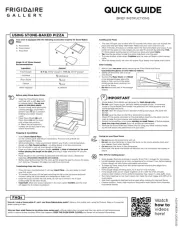
8 Oktober 2025
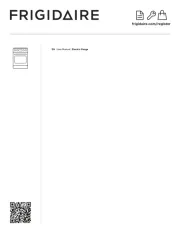
7 Oktober 2025
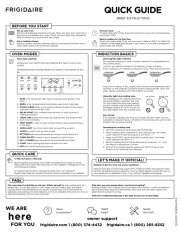
7 Oktober 2025
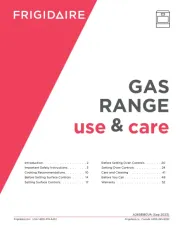
12 September 2025
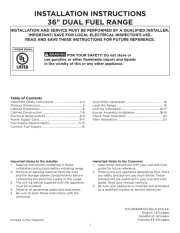
26 August 2025
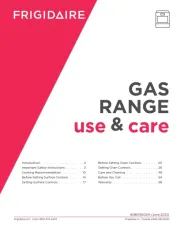
1 August 2025
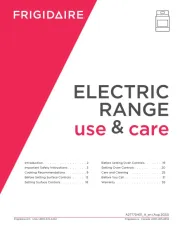
1 August 2025
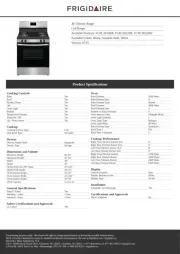
1 August 2025
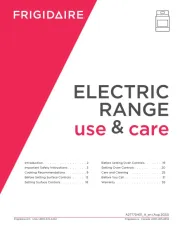
1 August 2025
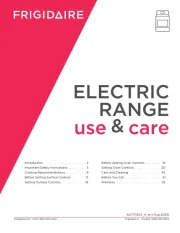
31 Juli 2025
Komfur Manualer
- Buderus
- Globe
- Kucht
- Rangemaster
- Arthur Martin-Electrolux
- Cata
- Kago
- NEO Tools
- Clas Ohlson
- TriStar
- Zelmer
- Marvel
- GE
- Iberna
- Scandomestic
Nyeste Komfur Manualer
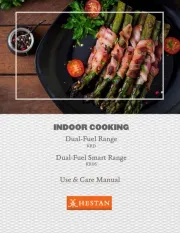
8 Oktober 2025
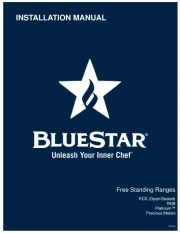
8 Oktober 2025
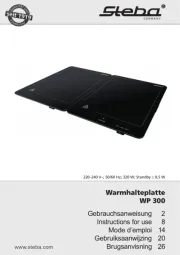
8 Oktober 2025
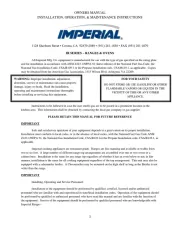
8 Oktober 2025

8 Oktober 2025
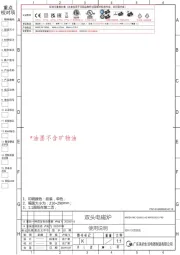
8 Oktober 2025
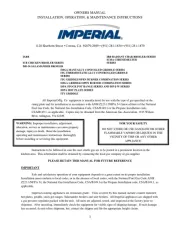
8 Oktober 2025
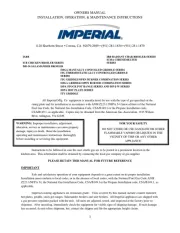
8 Oktober 2025
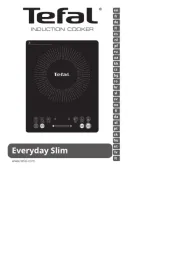
8 Oktober 2025
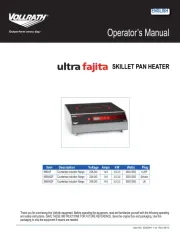
8 Oktober 2025